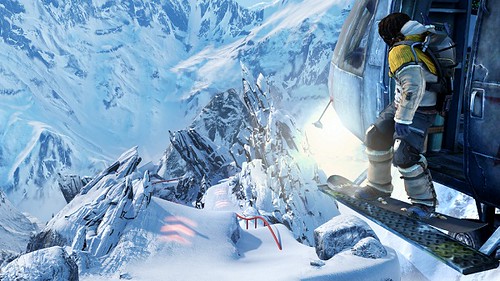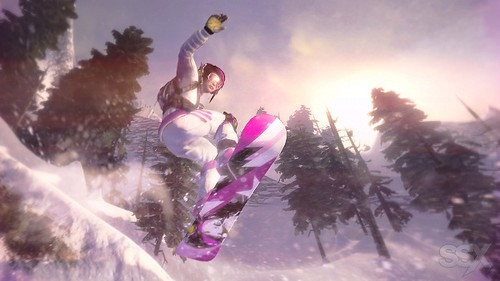|
Disclosure: We may earn a commission from links on this page
|
Developer: EA Canada | Publisher: Electronic Arts |
| Release Date: February 28, 2012 | Available On: PS3 and Xbox 360 |
I bet if I asked you to name three snowboarding games that have come out in the last ten or so years you’d be at a loss for words. I also bet that after reading that sentence, you tried, and failed. This is because since its release, SSX has reigned supreme over the genre, out shredding any competition and leaving them under an avalanche of fun and 1980’s hip-hop samples. After five years of inactivity, EA has decided to bring the Yeti-sized franchise out of hibernation to remind everyone how it’s done.
Simply titled “SSX”, the game’s story, as usual, doesn’t have too much substance. A skilled rider named Griff has left the SSX team and is essentially stealing all their fans and glory. To get back, team SSX has decided to conquer 9 deadly descents around the world. And that’s about as far as it goes. You get short character bios by means of comic book style cinematics in between each mountain range but other than that, there’s not much too it.

SSX has three modes to play: World Tour, Explore, and Global Events all tied together with RiderNet. Everything you do will net you credits, which serve as in game currency which is fine, but attaining credits is incredibly easy and you’ll often have far more than you need. World Tour is your standard “campaign”, where you’ll go from one mountain range to the next competing in different challenges until you reach the range’s “Deadly Descent”. The Deadly Descents usually involve some quirk to the gameplay that you’re not used to. For instance, one descent has you racing against an oncoming avalanche in top down view while others might have you avoiding trees or boarding on ice with lots of big turns.
Each range that you go to will unlock a new character, as well as a new “gear” option for you to equip your character with. Gear can be active or passive, depending on what level you’re playing on and essentially helps you survive in the harsh climates that you’ll be carving down. Gear can be wingsuit that, when deployed, lets you to glide through the air for a limited amount of time, allowing you to fly across large crevasses that you normally would not be able to clear. It could also be armor that dampens the damage you receive when you to run into things like trees and rocks. Some levels even require that you equip certain gear before you can drop in.
Explore lets you trick or race on any mountain range available in the game. The cool part is that if you set a record on any level, the score gets recorded and posted for all of your friends to see so your they can compete against you. In addition, a “ghost” of your run will also be uploaded to the track, so that when friends play the track, they’ll be able to watch what you did and where you went. You’ll also receive credits any time one of your friends fails to beat a record that you’ve set on a course. You can also place “geotags” around different levels, which are essentially little markers that your friends try to grab as they’re riding down the mountain.
Every time one of your friends goes down a slope and doesn’t grab a geotag you’ve placed on it, you’ll be awarded experience and credits. Even after someone does reach it, you’ll receive exp and credits for the amount of time it remained without being grabbed. This is an excellent way to encourage players to take new routes in order to find tricky spots to place their geotags for maximum points.
In addition to gear you can deck out your rider with different boards, outfits, mods and geotags. Certain outfits and boards grant special perks to the rider, while others are purely aesthetic. Mods are temporary stat boosters that you can take into the course with you. As your character levels up you’ll be able to equip more items to your rider.
Global Events are online events that anyone can join at any time. There’s usually a drop price to enter, which is then added to the total prize pool. The event is then split into brackets ranging from platinum at the top down to bronze at the bottom. Once you pay your drop fee and equip your character, you drop in and do as many (or as few) runs you can before the event is over. After you finish, you’ll be placed in a specific bracket depending on your score. What bracket you end up in determines the amount of credits you get to take home when the event ends. Global events can have thousands of riders competing at any given time, so the scores and brackets will shift frequently. You’ll also see all the other players riding the course you’re on in real time. While this set up is cool, it would have been nice to have some sort of head to head race where you can race or trick against your friends in a more traditional sense.
While SSX’s set up has changed playing the game has remained largely the same – in a good way. Getting mad air and pulling off crazy combos is still the name of the game. The HUD is minimal, but very good at telling you everything you need to know, including how long your combo is, how many points it’s worth, how many points you currently have, the amount of time before your combo ends, and your current standing. The game strongly encourages you to string together combos and even has a nose-press and tail-press move that can be done on the ground – similar to a manual in Tony Hawk – that will stop the combo timer and help you link together huge strings of moves. You get very few points for pulling off duplicate tricks so make sure you use a wide variety of moves.
In addition to regular moves which are pulled off by the four buttons (or analog stick) there are “uber-tricks” which are available after you fill your Tricky meter once. If you fill the meter again, you’ll reach super Tricky, where you’ll have infinite boost, and be able to pull off each characters signature move, which is normally something that would make Issac Newton roll in his grave.
SSX is no technical masterpiece, it most certainly looks great. While everything blends together a bit on the slopes, there will be times where you hit a huge jump and see a beautiful sunset cascading over the mountains in the background that truly gives you the feeling of grandeur. The soundtrack is an excellent dubstep and indie rock mix that completely captures the feeling of flying through the air down a mountain. Music will get softer as you hit a huge jump, then drop back in full force as you land (or crash), tying the whole experience together seamlessly.

More important than the graphics, it’s the feeling that you get when playing this game that makes the presentation stand out. The way everything fits together – the music, the blur effect you get when boosting, the scenery – creates an amazingly immersive experience that will have you subconsciously crunching your toes when you hit a big jump, or turning the controller the direction your character is spinning. As far as uniqueness goes, there aren’t many other games that can give you the same type of feeling as boosting down a mountain will full tricky.
While there’s not a whole lot of content in SSX, the game is still the epitome of fun, and will have you coming back for more. RiderNet makes online competition and stat tracking quick, easy, fun, and is a unique alternative to traditional online play. EA has shown us that even after a five year break, SSX still remains king of the hill (mountain?).
| Graphics: | 8 |
| Sound: | 9.5 |
| Gameplay: | 8.5 |
| Creativity: | 7 |
| Replay Value/Game Length: | 9.5 |
| Final: | 8.5 out of 10 |
| Written by Matt Evangelista | Write a User Review |